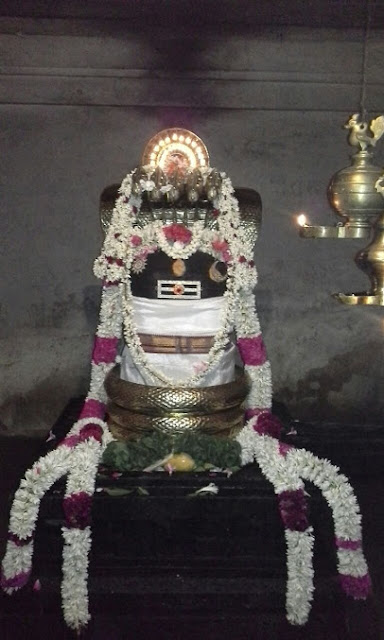Pattabi Ramar Temple, Mathi Krishnapuram, Puducherry
Pattabi Ramar Temple is a Hindu Temple dedicated to Lord Vishnu located at Mathi Krishnapuram near Mullodai in Bahour Commune in Union Territory of Puducherry, India. Mathi Krishnapuram is popularly called as Krishnavaram. This Temple is one of the famous Vaishnavite Temple, probably oldest Vaishnavite Temple in Puducherry Region.
Legends
There was a historical incident between the construction of this Temple. A King was ruling the surrounding areas with capital at Devanampattinam in present day Cuddalore District . He decided to build a fort at his capital. He informed his plan to his minister Krishnan. He sourced the rocks from Thiruvakkarai Hills. Vehicles carrying the rocks would pass through Mathi Krishnapuram.
Mathi Krishnapuram was abound with lakes and natural scenery, people used to take a break at this beautiful village. Krishnan used to supervise the works. While he was taking rest in Mathi Krishnapuram, he fell asleep. Lord Rama with Seetha Devi in Pattabhisheka Posture appeared in his dreams and blessed him. Krishnan decided to build a temple for Lord Rama in this place.
To realize his wish, he instructed the workers carrying the rocks to Devanampattinam should drop one rock in this village towards the construction of Rama Temple. He built this Temple with these stones. He informed about this Temple to the King and requested to grace the Kumbabhishekam of this Temple. Acceding to his request, he participated in the consecration ceremony and named this village after his minister. Hence, the village came to be called as Mathi Krishnapuram.
History
The Temple is believed to be built in 15th Century AD. The last consecration ceremony took place on 04.06.2015.
The Temple
This temple is facing towards west with an entrance arch. The Sanctum Sanctorum consists of Sanctum, Antrala, Maha Mandapam, Ardha Mandapam and Mukha Mandapam. The Mukha Mandapam connects the Ardha Mandapam with the entrance arch. Dwajastambam and Balipeedam can be found in the Mukha mandapam facing the sanctum. There is a shrine for Chakrattazhvar immediately after the entrance on the left side in the Mukha Mandapam.
There are ten pillars in the Mukha Mandapam. Each pillar is having a beautiful stucco image of Dasavatharam (Hayagriva, Matsya, Kurma, Varaha, Vamana, Narasimha, Parasurama, Rama, Krishna and Balarama Avatharams). Stucco images representing scenes from Ramayana, Mahabharata, Vaikunda and Vaishnavism can be seen on the upper side of the walls in the Mukha Mandapam.
Presiding Deity is Pattabi Ramar. He is gracing the devotees along with Seetha Devi, Lakshmana and Hanuman from the sanctum. He is in sitting posture facing west. He is depicted in his coronation form. Utsava Idol of this Temple is Sarangapani with Sridevi and Bhoodevi. Garudazhwar Shrine, The Vimanam over the sanctum is about 37 feet high.
There are shrines and idols of Thumbikai Azhwar, Vishnu Durga, Vishwakasena, Nammazhvar, Ramanuja and Alavandar in the Temple premises. Theertham associated with this Temple is Sri Rama Thirukulam. It is located outside the temple premises. It covers an area of about 5 acres.
There are ruins of old pillars can be seen at the back of the sanctum. This temple also has 27 feet tall temple chariot. There is another small Rama Temple situated at about 200 meters from this Temple. The pillars found at the entrance of this temple seems to be ancient. This Temple is situated at about 200 meters from Pattabi Ramar Temple.
Temple Opening Time
The Temple remains open from 06.00 AM to 12.00 Noon and 04.00 PM to 09.00 PM.
Festivals
10 Days Chithirai festival, Theppam Festival, Parivettai, Vaikunda Ekadasi, Krishna Jayanthi, Uriyadi Utsavam, Masi Magam and Aatru Tiruvizha are the festivals celebrated here with much fanfare.
Prayers
People pray to Lord to get rid of family problems, for child boon, to get relief from debts and to get rid of enemies.
Contact
Pattabi Ramar Temple,
Mathi Krishnapuram,
Bahour Commune,
Puducherry – 605 106
Mobile: +91 99940 46109
Connectivity
The Temple is located at about 600 meters from Mullodai Bus Stop, 1 Km from Kanniyakoil, 6.5 Kms from Cuddalore, 6.5 Kms from Cuddalore Bus Stand, 10 Kms from Cuddalore Port Junction Railway Station, 13 Kms from Ariyankuppam, 18 Kms from Puducherry Main Bus Stand, 18 Kms from Puducherry Railway Station, 21 Kms from Puducherry Airport, 162 Kms from Chennai Airport and 172 Kms from Chennai.
The Temple is situated on Pondicherry to Cuddalore Bus Route. Devotees can get down at Mullodai Bus Stop. All the buses plying between Pondicherry and Cuddalore will stop at this Bus Stop. The Temple is located at about ½ Km from this Bus Stop. Devotees can reach this temple by walk. Taxis and Autos are also available to reach this Temple from any part of Puducherry. Nearest Railway Station is located at Puducherry. Nearest Airport is located at Puducherry and Chennai.
Location | Photos











































